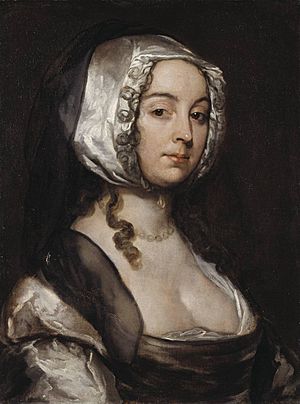William Dobson facts for kids
William Dobson (born 1611, died 1646) was a very important English painter, especially known for his portraits. A famous writer named John Aubrey once said he was "the most excellent painter that England has yet bred." Dobson died quite young, and his last years were difficult because of the English Civil War.
Contents
Dobson's Early Life and Training

William Dobson was born in London. His father, also named William Dobson, was a lawyer. Young William was baptized at St Andrew's Holborn church.
He started his art training with William Peake. Later, he probably worked in the studio of Francis Cleyn. Some people thought his father was an artist too, but this might be a misunderstanding.
Dobson was lucky enough to see the Royal Collection of art. This was a huge collection owned by King Charles I of England. He copied paintings by famous artists like Titian and Anthony van Dyck. Van Dyck was the main painter for King Charles at the time. Dobson's paintings show influences from Venetian art, especially in their colors and textures. However, Van Dyck's painting style didn't seem to influence Dobson much.
There's a story that Van Dyck discovered Dobson's talent after seeing one of his paintings in a shop. But there's no real proof for this story. We also don't know exactly how Dobson met the King. Once they met, King Charles asked Dobson to paint him, his sons, and other important people at court.
Working for the King

We don't know much about Dobson's work in the 1630s. But when Van Dyck died in 1641, Dobson had a great chance to get royal painting jobs from King Charles.
Some say he became the King's "serjeant painter" and "groom of the privy chamber." These were important roles. However, this claim comes from only one old source, and it hasn't been fully checked.
During the English Civil War, Dobson lived in Oxford. This city was a main base for the King's supporters, called Royalists. Dobson painted many important Royalist leaders there.
His portrait of the future King Charles II when he was about twelve years old is very famous. It's a great example of the baroque art style and might be his best work. He also painted the head of the Duke of York (who later became King James II). Other Royalists he painted include Charles Lucas, John Byron, 1st Baron Byron, Prince Rupert of the Rhine, and Prince Maurice.
Dobson's Paintings and Later Life
About sixty of Dobson's paintings still exist today. Most of them are portraits that show the person from the waist up. Many of these date from 1642 or later, during the war.
In his earlier works, Dobson used a lot of thick paint, called impasto. But later, he used much thinner layers of paint. This might have been because materials were hard to find during the war.
After Oxford was taken by the Parliamentarian army in June 1646, Dobson went back to London. He no longer had the King's support. He faced money problems and was briefly put in prison because of debt. He died poor at the age of thirty-five.
Art experts have praised Dobson's work. Ellis Waterhouse called him "the most distinguished purely British painter before Hogarth." And Waldemar Januszczak said he was "the first British born genius, the first truly dazzling English painter."
You can see Dobson's paintings in many places. These include the National Gallery and Tate Britain in London, the National Gallery of Scotland, and the National Portrait Gallery. His art is also in museums like the Walker Art Gallery in Liverpool and the Yale Center for British Art in the USA. Some of his works are in beautiful English country houses, like Alnwick Castle.
In 2011, there were special events to celebrate the anniversary of his birth. These included art shows, a "Dobson Trail" website listing his paintings, and a BBC TV show about him called The Lost Genius of British Art: William Dobson.
Dobson's Family Life
William Dobson was married twice. His first wife was Elizabeth, but we don't know her last name or when they got married. She was buried in St Martin-in-the-Fields in 1634. On December 18, 1637, he married Judith Sander, who lived longer than he did.
Images for kids
-
Richard Neville, no date
See also
 In Spanish: William Dobson para niños
In Spanish: William Dobson para niños











